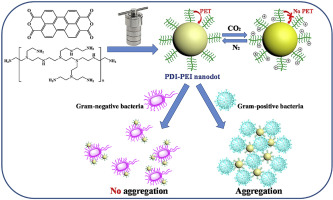Dyes and Pigments ( IF 4.1 ) Pub Date : 2020-01-27 , DOI: 10.1016/j.dyepig.2020.108245 Hao Zhe Wang , Ling Gui Ning , Wen Yi Lv , Lan Xiao , Chang Ming Li , Zhi Song Lu , Bin Wang , Li Qun Xu

|
Perylene diimides (PDIs) derivative was prepared by hydrothermal treatment of perylene dianhydride (PTCDA) and ethylenediamine branched polyethylenimine (PEI) in the absence of toxic solvent and catalyst. The resulting PDI-PEI nanodots emit weak fluorescence due to the photoinduced electron transfer (PET) process from alkylamine units to PDI fluorophore. In acidic pH environment or in the presence of dissolved CO2, the PET effect can be eliminated to trigger the fluorescent “turn-on” response of the PDI-PEI nanodots. This chemosensor exhibits CO2 concentration-dependent fluorescence response and can be utilized to detect the dissolved CO2. This chemosensor also exhibits fluorescence reversibility for the dissolved CO2 by purging the system with CO2 and degassing with N2 alternatively. Upon incubation with different bacteria and centrifugation of the co-cultured bacterial suspensions, the PDI-PEI nanodots can be used to predict their antibacterial properties by observing the color changes of the collected bacterial cakes via naked eye. In addition, the co-cultured bacterial suspensions containing Gram-positive bacteria aggregate and form purple precipitates. The PDI-PEI nanodots can also be used to distinguish Gram-positive bacteria by observing the aggregation and sedimentation phenomenon on the co-cultured bacterial suspensions via naked eye.
中文翻译:

基于synthesis二酰亚胺的纳米点的绿色合成,用于二氧化碳感测,抗菌活性预测和细菌识别
hydro二酰亚胺(PDIs)衍生物是通过在不使用有毒溶剂和催化剂的情况下对thermal二酸酐(PTCDA)和乙二胺支化的聚乙烯亚胺(PEI)进行水热处理而制得的。由于从烷基胺单元到PDI荧光团的光致电子转移(PET)过程,所得的PDI-PEI纳米点发出的荧光很弱。在酸性pH环境中或存在溶解的CO 2的情况下,可以消除PET效应,从而触发PDI-PEI纳米点的荧光“开启”响应。该化学传感器表现出依赖于CO 2浓度的荧光响应,可用于检测溶解的CO 2。该化学传感器还显示出溶解的CO 2的荧光可逆性通过用CO 2吹扫系统并用N 2脱气。在与不同细菌温育和共培养的细菌悬浮液离心后,PDI-PEI纳米点可用于通过肉眼观察收集的细菌饼的颜色变化来预测其抗菌性能。另外,含有革兰氏阳性细菌的共培养细菌悬浮液聚集并形成紫色沉淀。PDI-PEI纳米点还可通过肉眼观察共培养细菌悬浮液上的聚集和沉降现象来区分革兰氏阳性细菌。











































 京公网安备 11010802027423号
京公网安备 11010802027423号